Thoroughly analyzing TS Inter 2nd Year Commerce Model Papers Set 4 helps students identify their strengths and weaknesses.
TS Inter 2nd Year Commerce Model Paper Set 4 with Solutions
Time: 3 Hours
Maximum Marks: 100
Part – I (50 Marks)
Section – A
(2 × 10 = 20)
Answer any two of the following questions not exceeding 40 lines each.
Question 1.
What is the procedure for listing securities?
Answer:
A company with a minimum issued capital of ₹ 3 crores of which at least ₹ 1.8 crores (60%) is offered to the public can apply for listing in the prescribed proforma along with the following documents.
- Copies of Memorandum of Association and Articles of Association, Prospectus, Directors Reports, Balance sheets and agreements with underwriters and brokers, etc.
- Specimen copies of shares and debentures certificates, letters of allotments, acceptance renunciation, etc.
- Particulars regarding capital structure.
- A statement showing the distribution of shares.
- Particulars of dividends and bonuses declared and or paid during the last 10 years.
- Particulars of shares or debentures for which permission to deal is applied.
- Brief report on the company’s activities since its incorporation.
- Listing agreement with a required initial and annual listing fee.
A new company may not be able to submit some of the above documents and it will not be an objection to enlisting. The central listing authority was set up in the year 2003 by SEBI as a self-regulatory organization. It is established to ensure uniform and standard practices for listing the securities in all Indian stock exchanges.
Question 2.
Discuss the advantages and disadvantages of E-Banking.
Answer:
Advantages of E-Banking:
- Round-the-clock services will be available to the customer for all 7 days a week i.e., 24 × 7.
- Fastness and flexibility in the transactions.
- Lower operating costs for banks.
- A higher degree of personalization.
- Increased speed and accuracy of information exchange.
- A bank account can be easily accessed from anywhere and at any time.
- Leads to greater customer satisfaction.
- Internet banking helps banks reduce the workload of their branches, such as the generation of statements, balance inquiries, etc.
- NRI’s can monitor their bank accounts in the bank in India from wherever they are stationed. They can operate their accounts anywhere in the world.
Disadvantages or Limitations of E-Banking:
- Problems may crop up regarding security and reliability.
- Imparting training to banking staff is a big challenge.
- Non-availability of internet connection with highspeed bandwidth in the rural areas.
- The high illiteracy rate in India is a hindrance to E-banking.
- Resistance to paperless transactions by the customer, as they may prefer evidence for their transactions on paper.
- Technology is advancing, and our legal environment is not in a position to keep pace with the technology.
![]()
Question 3.
“A successful enterprise has to achieve its goals effectively and efficiently”. Explain.
Answer:
Management is the process of planning, organizing, directing, and controlling the enterprise resources efficiently and effectively for achieving the goals of the organization. Effectiveness in management is concerned with doing the right task, completing activities, and achieving goals. Efficiency means doing the task correctly and with minimum cost the key features of management are:
- Goal-oriented process
- All pervasive
- Multi-dimensional
- Continuous process
- Group activity
- Dynamic function
- Tangible force
The management fulfills three basic objectives they are:
- Organizational Goals
- Social Goals
- Personal Goals
Management is important because it helps in achieving group goals. Increases efficiency, creates a dynamic organization, helps achieve personal objectives, and contributes to the development of society. Management is a combination of an organized body of knowledge and its skillful application. The purpose of management is to achieve certain goals. If the objective of the company is to maximize profit, steps may be taken to reduce the cost of production.
Section – B
(4 × 5 = 20)
Answer any four of the following questions not exceeding 20 lines each.
Question 4.
What is the role of commercial banks in the Money Market?
Answer:
Organized money markets are regulated by RBI (or) NABARD and commercial banks. Indian and foreign public sector and private sectors are treated as organized sectors. All these institutions participate on the demand side along with Central Government business entities and individuals. The requirement of finance for the Government arises because of a deficit for firms to meet their working capital needs and for banks to maintain the cash reserve ratio. On the supply side, funds come from the central bank, commercial banks, rural banks, and Cooperative banks. Various financial institutions participate in all the sub-markets but not to the level of commercial banks. One can say that the development of the money market depends upon the development of that country’s banking system.
Question 5.
What is IRDA? Explain the powers and functions of IRDA.
Answer:
On the recommendations of the Malhotra committee, the Government set up the Insurance Regulatory and Development Authority as a regulatory body to regulate and control the insurance business in India.
Powers and Functions of IRDA:
- Protection of interests of policyholders in matters concerning assigning of policy nomination by policy holders, insurable interest, settlement of insurance claim, surrender value of policy, and other terms and conditions of the contract of insurance.
- Specifying the requisite qualifications and practical training for insurance intermediaries or agents.
- Specifying the code of conduct for surveyors and loss assessors.
- Promoting efficiency in the conduct of the insurance business.
- Promoting and regulating professional organizations connected with insurance, reinsurance business, levying fees, and other charges for carrying out the purpose of the IRDA Act.
- Calling for information from undertaking an inspection of conducting inquiries and litigations, including audit of insurers, insurance, intermediaries, and other organizations connected with the insurance business.
- Regulating investment of funds by insurance companies, regulating the maintenance of margin of solvency.
- Adjudication of disputes between insurers and intermediaries.
- Supervising the functioning of the tariff advisory committee.
- Exercising such other powers as may be prescribed.
Question 6.
Explain the functions of entrepreneurs.
Answer:
The functions of Entrepreneur are:
1. Innovation:
Innovation is also different from invention. Invention implies the discovery of new ideas, new articles, and new methods, whereas innovation means the application of inventions and discoveries to make new and desired products and services that can be successfully sold in the market.
2. Risk Bearing:
Entrepreneurs in the game of business where risks and rewards are plenty will be ready to accept them.
3. Organisation and Management:
As rightly said by Alfred Marshall organization and management of the enterprise is the main function of an entrepreneur. He makes required alternations in the size of the business, its location, techniques of production, etc. The entrepreneur also undertakes managerial functions like formulation of production plans, organization of sales, and personnel management.
4. Business Planning:
The entrepreneur must provide logical and scientific basics for planning the business operations, the need for raw materials and men, production schedules, etc. For systematic business planning, the entrepreneur must be able to formulate goals, policies, procedures, programs, and budgets.
5. Decision Making:
Another important function discharged by the entrepreneur is decision-making. He has to make decisions regarding the activities of the enterprise.
![]()
Question 7.
What factors influence a person to become an entrepreneur?
Answer:
The decision to become an entrepreneur is influenced by several factors which are presented in the following.
Factors Influencing Decision
Internal Factors
- Educational background.
- Occupational experience.
- Desire to work independently in the manufacturing line.
- Desire to branch out to manufacturing.
- Family background.
- Other factors.
External Factors
- Assistance from the Government.
- Assistance from financial institutions.
- Availability of technology and raw materials.
- Demand for the product.
- Utilization of excess funds.
Question 8.
List out the advantages of export trade.
Answer:
The following are the advantages of export trade.
- Due to export trade, every country can make optimum use of available natural resources.
- Wastage of resources is avoided.
- Export trade leads to an increase in income.
- Export trade and specialization a wide range of commodities can be made available at cheaper rates.
- Economically underdeveloped countries may develop their industries with machinery, and technologies, imported from other countries.
- Increase employment opportunities.
- Increase foreign exchange reserves.
Question 9.
Explain any two important characteristics of management.
Answer:
The following are the important characteristics of management.
- It is an economic activity.
- It gets things done through others.
- It is a creative activity.
- It co-ordinates efforts.
- It is a process.
- It is goal-oriented.
- It acts as a group.
- It is a discipline.
1. It is an economic activity:
Management is part and parcel of every economic activity of a man who struggles for a better living in his existing society, the fate of which is rather molded by management under different aspects like planning, coordinating, controlling, etc., It is the total of those activities.
2. It gets things done through others:
It is its purpose that management gets things done through other people. It does not perform the work itself but helps to do it. It co-ordinates individual actions into a team. In any organization, a group of people is involved in working towards a common objective. Whatever the managers do they have some purpose in it. Managers motivate people to get things done through them.
3. It is a creative activity:
Management is a creative activity- purposeful activity-group activity-motivating activity-economy oriented activity-delegating activity and above all, a decision-making activity.
Section – C
(5 × 2 = 10)
Answer any five of the following questions not exceeding 5 lines each.
Question 10.
Bull
Answer:
Bull: A Bull or Tejawalla is an operator who expects a rise in the prices of securities in the future. In anticipation of a price rise, he makes purchases of shares and debentures to sell at higher prices in the future. He being a speculator has no intention of taking delivery of securities but deals only in difference of prices. Such a speculator is called ‘Bull’ because of the resemblance of his behavior with the bull. A bull tends to throw his victims up in the air. Similarly, a bull speculator tries to raise the prices of securities by placing big purchase orders.
Question 11.
Mobile Banking.
Answer:
This service is provided free of cost to all customers of the bank, irrespective of their mobile service network provider and the make of the handset owned by the Customer. Customers to know their account balance and debit and credit transactions of the account etc., through alerts.
Question 12.
Entrepreneurship.
Answer:
It is a purposeful activity of an individual or a group of associated individuals undertaken to initiate, maintain, and earn profit by the production or distribution of economic goods and services.
![]()
Question 13.
Industrial Licence.
Answer:
Various administrative bodies have been set upto consider requests for the issue of industrial licenses, import of capital equipment, foreign collaboration, etc.
Question 14.
Internal Trade.
Answer:
Internal trade: Internal trade is conducted within the political and geographical boundaries of a particular country. It can take place at the local regional or national level.
Question 15.
Consumer Co-operative Store
Answer:
Consumer co-operative store: A consumer co-operative store is defined as “a voluntary association of persons based on co-cooperative principle for buying in common and selling in common.
Question 16.
Exchange Rate.
Answer:
The rate at which the currency of one country is exchanged for the currency of another country is known as the exchange rate.
Question 17.
Two Features of Planning
Answer:
The following are the features of planning:
- Planning is an intellectual process.
- Planning is goal-oriented.
- Planning is a primary function of management.
- Planning is directed towards efficiency.
Part – II (50 Marks)
Section – D
(1 × 20 = 20)
Note: Answer the following question.
Question 18.
Mr. X and Y are partners sharing profits and losses in the ratio of 4 : 1. Their balance sheet as of 31 March 2015 was as follows.

They agreed to take Mr. Z into partnership with effect from 1st April 2015 on the following terms:
(a) Mr. Z brings ₹ 40,000 towards goodwill and ₹ 60,000 as capital.
(b) The assets are revalued as under:
Furniture ₹ 50,000
Stock ₹ 78,000
Debtors ₹ 58,000
(c) The goodwill will be retained in the business.
Prepare necessary ledger accounts and prepare the balance sheet of the new firm.
Answer:
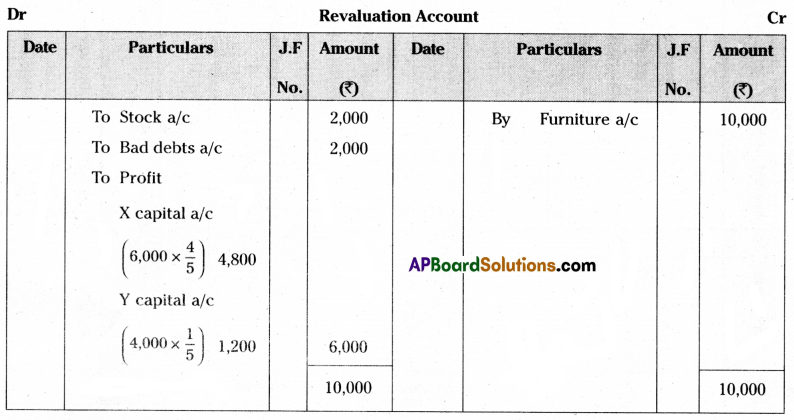
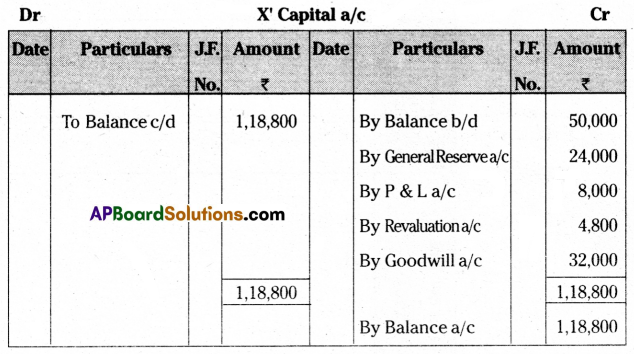
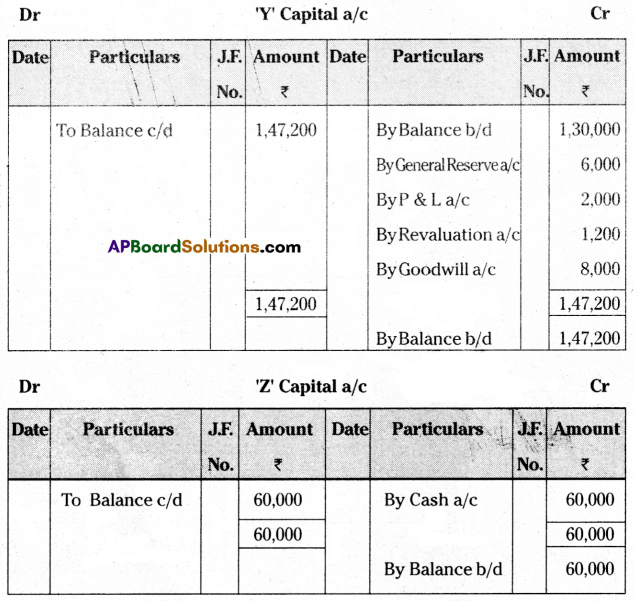
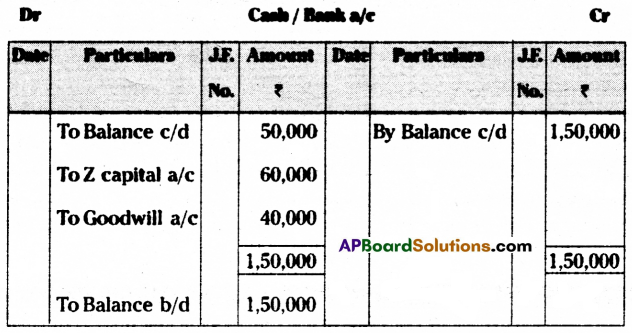
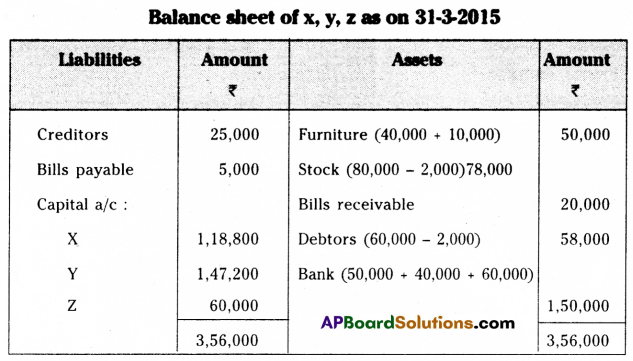
Section – E
(1 × 10 = 10)
Answer any one of the following questions.
Question 19.
Anand of Hyderabad consigned goods worth ₹ 20,000 to his agent Arvind of Kodad on consignment. Anand spent ₹ 1,000 on transport, and ₹ 500 on insurance. Arvind sent ₹ 5,000 as advance. After two months, Anand received the account sales as follows.
(a) Half of the goods were sold for ₹ 24,000
(b) Selling expenses were ₹ 1,200
(c) 10% commission on sales.
Give ledger accounts in the books of both parties.
Answer:



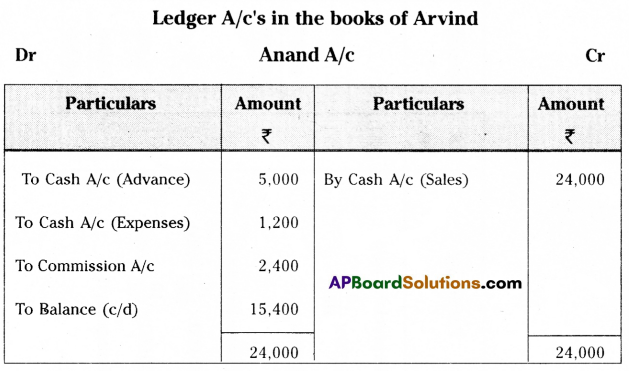
![]()
Question 20.
From the following information, prepare the income and expenditure account for the year ended 31-03-2015 of ‘Kamareddy Cricket Club’.
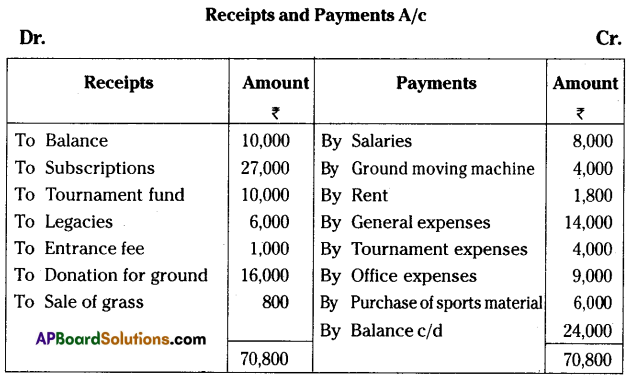
Additional Information:
1. Subscriptions received included an amount ₹ 4,200 related to the previous year.
2. Outstanding subscription ₹ 1,000.
3. Provide ₹ 400 depreciation on the ground moving machine.
4. Sports material opening balance ₹ 4,000 and closing balance ₹ 5,000.
Answer:
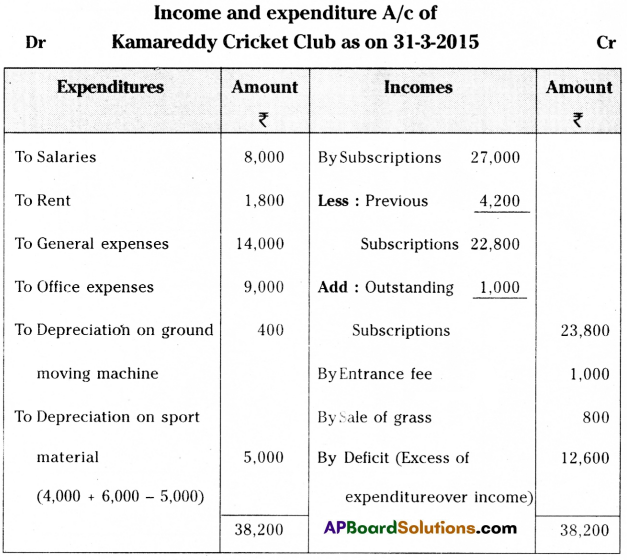
Section – F
(2 × 5 = 10)
Answer any two of the following questions.
Question 21.
Kiram & Sons purchased a machine for ₹ 42,000 and paid ₹ 3,000 for its erection on 1st April 2009. Additions are made to the machine on 31st March 2010 for ₹ 20,000. Accounts are closed at the end of the financial year. Depreciation is allowed at 10% under the fixed installment method. Prepare machine a/c for three years.
Answer:
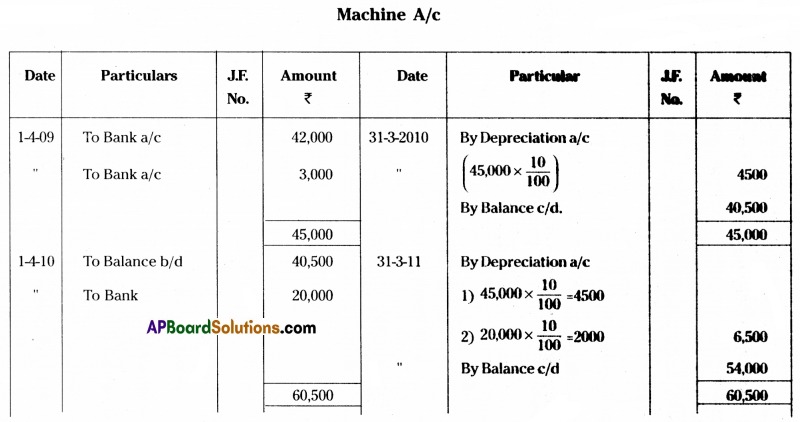

Question 22.
Ascertain the profit earned by M/s. Rama & Co. keeps their books under a single-entry system.
Excess of assets over liabilities on 1-4-2014: ₹ 56,000
Excess of assets over liabilities on 31-3-2015: ₹ 73,000
Fresh capital introduced during the year: ₹ 14,000
Drawings during the year: ₹ 1,500 per month
Answer:
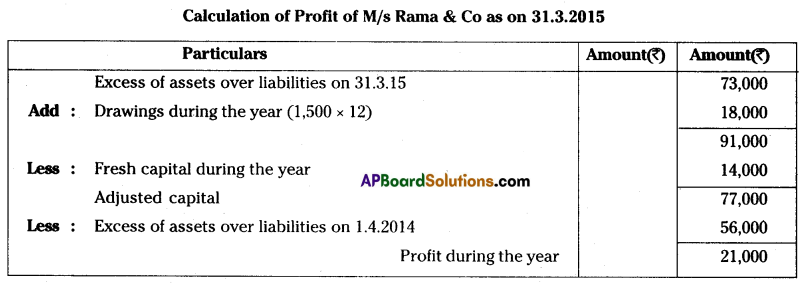
Question 23.
What is an Income and expenditure account, explain its features.
Answer:
The income and expenditure account is like the profit and loss account of profit-making organizations. It is a nominal account so, the accounting principle of a nominal account “Debit all losses and expenses and credit all gains and incomes” will be followed. All the expenses and losses are shown on the debit side and all the gains and incomes are shown on the credit side of the income and expenditure account.
Features:
- It is similar to a profit and loss account.
- It is a nominal account.
- All revenue expenses are recorded on the debit side and all revenue incomes are on the credit side of the income and expenditure account.
- Only revenue items are taken into consideration. Capital items are to be excluded.
- There is no closing balance but the difference between the two sides of the account shows either a surplus or deficit.
- It also records non-cash items like depreciation.
- The surplus/deficit is transferred to the capital fund in the balance sheet.
Question 24.
Explain any five advantages of computerized accounting.
Answer:
The following are some of the advantages of using computerized accounting:
- Automation: Since all the calculations are handled by the software, computerized accounting eliminates many of the routines.
- Accuracy: This accounting system is designed to be accurate to the minute detail.
- Data Access: Using accounting software, it becomes much easier for different individuals to access accounting data outside of the office securely.
- Reliability: Because of the accurate calculations, the financial statements prepared by computers are highly reliable.
- Speed: Using accounting software, the entire process of preparing an account becomes faster.
Section – G
(5 x 2 = 10)
Answer any five of the following questions.
Question 25.
What is Obsolescence?
Answer:
Diminution (reduction) in the value of fixed assets due to new inventions, new improvements, changes in fashions, and changes in customers’ tastes and preferences.
Question 26.
How to calculate Profit/Loss in a single entry system?
Answer:
Calculation of profit/loss on the single entry system.
Statement showing profit or loss of _______ for the year ending

Question 27.
Recurring expenses in consignment.
Answer:
The following gives details of recurring expenses incurred by the consignor and consignee.
Recurring expenses incurred by consignor
- Bank charges for discounting the bills or cheques received.
- Expenses incurred on damaged goods.
Recurring expenses incurred by consignee
- Godown rent
- Godown insurance
- Salary to salesmen
- Advertisement charges
- Selling expenses
- Salesmen commission
Question 28.
Difference between Capital expenditure and revenue expenditure.
Answer:
Capital expenditure is generally incurred for the acquisition of assets or to increase the earning capacity whereas revenue expenditure whose benefit expires on or before the accounting period.
Question 29.
Radha and Rani share profits in the ratio of 4 : 3. Mamatha admitted into business for 1/8th share in the future profits. Calculate the new profit-sharing ratio.
Answer:
Old Ratio of Radha and Rani = 4:3
Give Share to Mamatha = \(\frac{1}{8}\)th
Total profits assumed ‘1’
Remaining Share = 1 – \(\frac{1}{8}\) = \(\frac{7}{8}\)
New Share of Radha = \(\frac{7}{8} \times \frac{4}{7}=\frac{28}{56}\)
New Share of Rani = \(\frac{7}{8} \times \frac{3}{7}=\frac{21}{56}\)
New Share of Mamatha = \(\frac{1}{8} \times \frac{7}{7}=\frac{7}{56}\)
New Ratio of Radha, Rani and Mamatha = \(\frac{28}{56}: \frac{21}{56}: \frac{7}{56}\) = 4 : 3 : 1
Question 30.
What is Goodwill?
Answer:
Goodwill is the reputation or good name associated with the name of a firm. Firms that have goodwill will enjoy continuous patronage of customers.
![]()
Question 31.
Purpose of using computerized accounting.
Answer:
A computerized accounting system renders its tremendous services to the business concerns to meet all the purposes. It improves accuracy, enhances reporting capabilities, and simplifies the recording of transactions. Accuracy increases because arithmetic processes occur automatically without human error. The business owner can record each transaction in the computerized accounting system as it occurs. This allows the system to pull the necessary information into different reports. The business owner can also create different reports in the system to run regularly.
Question 32.
HDPOS (HD Accounts and Billing)
Answer:
HD Accounts & Billing (HDPOS): HDPOS (Hyper Drive Point of Sale) is one of the best accounting softwares developed by Hyper Drive Information Technologies Private Ltd. Bangalore. It has ease of use and a nice interface and it is a “Windows-based billing”, Inventory. HDPOS allows the creation, editing, and saving of the details of company accounts.